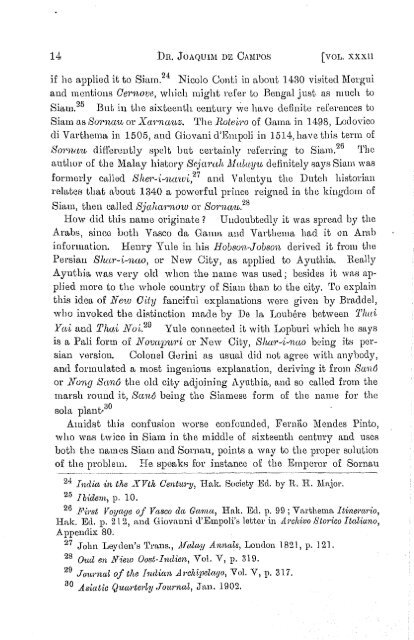The Journal of the Siam Society Vol. XXXII, 1940 - Khamkoo
The Journal of the Siam Society Vol. XXXII, 1940 - Khamkoo
The Journal of the Siam Society Vol. XXXII, 1940 - Khamkoo
Create successful ePaper yourself
Turn your PDF publications into a flip-book with our unique Google optimized e-Paper software.
14 Dn. JOAQUIM DE 0A"!Ill'OS [VOL. XXX!l<br />
if he applied it to Sium. 24 Nicolo Conti in about 1430 visited Mergui<br />
and mentions Cernove, which might refer to Bengttl just as much to<br />
<strong>Siam</strong>. 25 But in tbe sixteenth century 've have definite references to<br />
<strong>Siam</strong> as Sm"nau or Xa1•nauz. 'l'he Boteiro <strong>of</strong> Gama in 1498, Loclovico<br />
di Var<strong>the</strong>ma in 150.5, and Giovanid'Empoli in 1514,havethis term <strong>of</strong><br />
Sor1Ut'tL differently spelt but certainly referring to <strong>Siam</strong>. 26 'l'he<br />
author <strong>of</strong> <strong>the</strong> Malay histot·y Sejar(th Malay'I.L definitely says <strong>Siam</strong> was<br />
formerly called Shm·-i-nctwi, 27 lLnd Valentyn <strong>the</strong> Dutch historian<br />
relates that about 1340 a powerful prince reigned in <strong>the</strong> kingdom <strong>of</strong><br />
<strong>Siam</strong>, <strong>the</strong>n called Sjahcw1ww or So?·na'l.u. 28<br />
How did this name originate? Undoubtedly it wtts spread by <strong>the</strong><br />
Arabs, since Loth Vasco da Ganm and Var<strong>the</strong>ma had it on Arab<br />
information. Henry Yule in his Hobson-Jobson derived it from <strong>the</strong><br />
Pet·siau Shc~r·-i-ncw, or New City, as applied to Ayuthia. Really<br />
Ayuthia was very old when <strong>the</strong> name was used; besides it was applied<br />
more to <strong>the</strong> whole countJ:·y <strong>of</strong> <strong>Siam</strong> than to <strong>the</strong> city. rro explain<br />
this idm~ <strong>of</strong> New City fanciful explanations were given by Bradclel,<br />
who invoked <strong>the</strong> distinction macle by De la Loubere between 1'luci<br />
Yc~i and Thcti Nui. 29 Yule connected it with Lopburi which he says<br />
is a Pali form <strong>of</strong> Novnp'I.L?'i or New City, Shar-i-new being its persian<br />
version. Colonel Gerini as usual did not agree with anybody,<br />
and formulated a most ingenious explanation, deriving it from Santl<br />
or Nung Scmu <strong>the</strong> old city adjoining Ayuthia, and so called from <strong>the</strong><br />
marsh ronnel it, Scmo being <strong>the</strong> <strong>Siam</strong>ese form <strong>of</strong> <strong>the</strong> name for <strong>the</strong><br />
30<br />
sola plant·<br />
Amidst this confusion worse confounded, Fernao Mendes Pinto,<br />
who was twice in <strong>Siam</strong> in <strong>the</strong> middle <strong>of</strong> sixteenth century and uses<br />
both <strong>the</strong> names <strong>Siam</strong> and Sornau, points a way to <strong>the</strong> proper solution<br />
<strong>of</strong> <strong>the</strong> problem. He speaks for instance or <strong>the</strong> Emperor <strong>of</strong> Sornau<br />
2 ' 1 Inclitt in <strong>the</strong> XJTtl~ Centu1·y, T!ak. <strong>Society</strong> Ed. by R. H. ])l:tjor.<br />
25 I bidemj p. l 0.<br />
26 Pi1·st Voyt£ge <strong>of</strong> Vrtsco dct Gctnut, Hr1-k. Ed. p. 99; Var<strong>the</strong>ma Itine?'Cwioj<br />
I-l:tlc. Ed. p. 21 2, and Giova.nni d'Empoli's lettm· in Arohivo Sto?'ico Italiano,<br />
Appendix 80.<br />
27 John Leyden's 'rmns., Jlfday Annals) London 1821, p. ] 21.<br />
28 Owl en Niew Oo.st-lnclicn, <strong>Vol</strong>. V, p. 319.<br />
29 J 07 wrwl <strong>of</strong> <strong>the</strong> Inclitm A ?·chipel{tyo, <strong>Vol</strong>. V, p. 317.<br />
30<br />
As·iatio Quw·terly .Tow·nal, Jan. Hl02.

















